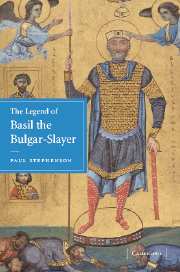 Paul Stephenson is the known writer of the famous book "The Legend of Basil the Bulgar-Slayer " that publish from the Cambridge(ISBN-13: 9780521815307 ISBN-10: 0521815304) . In the page 134 describes two incidents that had with the Slav Macedonians regarding the history of this Greek Byzantine Leader.
Paul Stephenson is the known writer of the famous book "The Legend of Basil the Bulgar-Slayer " that publish from the Cambridge(ISBN-13: 9780521815307 ISBN-10: 0521815304) . In the page 134 describes two incidents that had with the Slav Macedonians regarding the history of this Greek Byzantine Leader. In July 1998 1 was sitting in front of the Church of Sv. Klimcnt (St. Clement), a thirteenth-century foundation on a hill which overlooks Ohrid in the Republic of Macedonia. The crest of the hill on the opposite side of the town is dominated by the ruins of an eleventh-century citadel, which Brailsford called “The Bulgarian Tsar’s fortress,” and modern tourist maps call more simply Samuil s Fortress. As I sat a local tour guide explained how this came to be. He told a version of the story of the battle of Kicidion, after which the blinded troops marched back to Samuel’s fortress, and the crud Greek king” Basil ever after was known as the “Macedonian-slayer.”A similar account is included in a recent national history, compiled by two journalists from Skopje, which includes a translation into Macedonian Slavic of Skylitzes’ account of the battle of Kleidion, with all references to Bulgaria and Bulgarians excised.”This was my reason for beginning this study, and so here also it will end.
Slav-Macedonism is the political idea prevailing in the Former Yugoslav Republic of Macedonia (FYROM) which utilises historical revisionism to establish links between an ethnic group that formed in the 20th century - ethnic 'Macedonians' - and historical events and figures of the 19th century and Middle Ages. The fYROMacedonian historiography basing her “stealing process” via the Historical revisionism. Historical revisionism is the attempt to change commonly held ideas about the past. In its legitimate form (see historical revisionism) it is the reexamination of historical facts, with an eye towards updating historical narratives with newly discovered, more accurate, or less biased information, acknowledging that history of an event, as it has been traditionally told, may not be entirely accurate. Historical revisionism can be used as a label to describe the views of self-taught historians who publish articles that deliberately misrepresent and manipulate historical evidence.
Paul Stephenson met this kind of historiography. As we know, the main characteristics of a nation are unity of country (with the meaning of common fatherland) and of political organisation, language, religion and heritage, which are joined by a common past, common consciousness - characteristics which alone are not enough or indeed necessary but which in combination create the separate identity of a nation. They tried to keep these characteristics to the new "republic of Macedonia". They wanted, in other words, to fabricate a nation. By means of their studies and publications they attemped to reconstruct and re-interpret historical data in order to fulfil their objectives.
Thanks to the Slav Macedonists of the FYROM we have now an amazing book of Paul Stephenson as regards the life of this Greek Byzantine leader.



Akritas I recommend that you actually read Stephenson's book because it will shock you to tears to learn the obvious that we all already know. That Basil was not a "greek Byzantine" but a Roman citizen of the highest order who was ethnically a Slav or Armeno-Slav. You should read this book because then you will see when the term "Bulgar Slayer" was used. And you will also learn that Samoil becoming the Tsar of the Bulgarian Kingdom which had no conotations to actual ethnicity. Just conquest. Sorry to mythbreak your lights out Akrita. Maybe we'll meet again when you've grown up and learned a little more about your own history as opposed to trying to dictate to others what their history is.
ReplyDelete